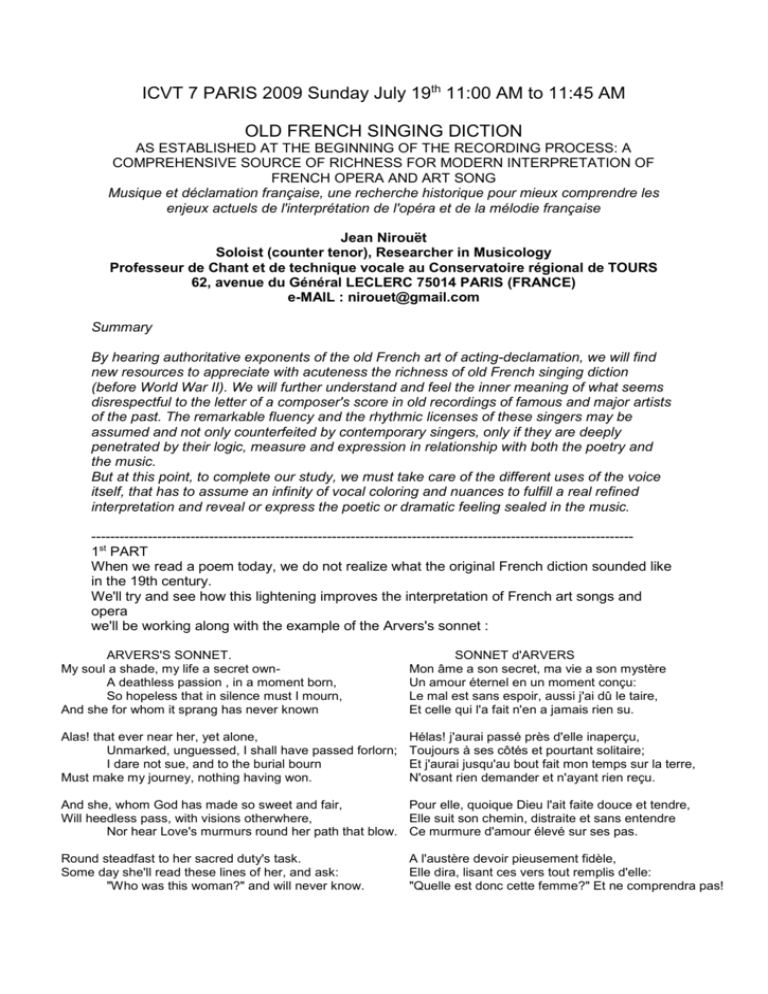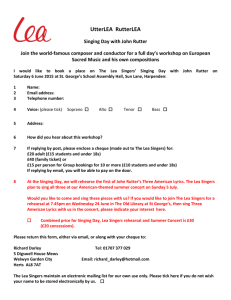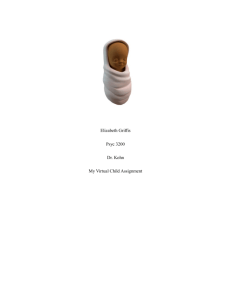ICVT version 2 anglais
advertisement

ICVT 7 PARIS 2009 Sunday July 19th 11:00 AM to 11:45 AM OLD FRENCH SINGING DICTION AS ESTABLISHED AT THE BEGINNING OF THE RECORDING PROCESS: A COMPREHENSIVE SOURCE OF RICHNESS FOR MODERN INTERPRETATION OF FRENCH OPERA AND ART SONG Musique et déclamation française, une recherche historique pour mieux comprendre les enjeux actuels de l'interprétation de l'opéra et de la mélodie française Jean Nirouët Soloist (counter tenor), Researcher in Musicology Professeur de Chant et de technique vocale au Conservatoire régional de TOURS 62, avenue du Général LECLERC 75014 PARIS (FRANCE) e-MAIL : nirouet@gmail.com Summary By hearing authoritative exponents of the old French art of acting-declamation, we will find new resources to appreciate with acuteness the richness of old French singing diction (before World War II). We will further understand and feel the inner meaning of what seems disrespectful to the letter of a composer's score in old recordings of famous and major artists of the past. The remarkable fluency and the rhythmic licenses of these singers may be assumed and not only counterfeited by contemporary singers, only if they are deeply penetrated by their logic, measure and expression in relationship with both the poetry and the music. But at this point, to complete our study, we must take care of the different uses of the voice itself, that has to assume an infinity of vocal coloring and nuances to fulfill a real refined interpretation and reveal or express the poetic or dramatic feeling sealed in the music. ------------------------------------------------------------------------------------------------------------------1st PART When we read a poem today, we do not realize what the original French diction sounded like in the 19th century. We'll try and see how this lightening improves the interpretation of French art songs and opera we'll be working along with the example of the Arvers's sonnet : ARVERS'S SONNET. My soul a shade, my life a secret ownA deathless passion , in a moment born, So hopeless that in silence must I mourn, And she for whom it sprang has never known SONNET d'ARVERS Mon âme a son secret, ma vie a son mystère Un amour éternel en un moment conçu: Le mal est sans espoir, aussi j'ai dû le taire, Et celle qui l'a fait n'en a jamais rien su. Alas! that ever near her, yet alone, Unmarked, unguessed, I shall have passed forlorn; I dare not sue, and to the burial bourn Must make my journey, nothing having won. Hélas! j'aurai passé près d'elle inaperçu, Toujours à ses côtés et pourtant solitaire; Et j'aurai jusqu'au bout fait mon temps sur la terre, N'osant rien demander et n'ayant rien reçu. And she, whom God has made so sweet and fair, Pour elle, quoique Dieu l'ait faite douce et tendre, Will heedless pass, with visions otherwhere, Elle suit son chemin, distraite et sans entendre Nor hear Love's murmurs round her path that blow. Ce murmure d'amour élevé sur ses pas. Round steadfast to her sacred duty's task. Some day she'll read these lines of her, and ask: "Who was this woman?" and will never know. A l'austère devoir pieusement fidèle, Elle dira, lisant ces vers tout remplis d'elle: "Quelle est donc cette femme?" Et ne comprendra pas! 2 R.W. New York, Sept. 28, 1898 (in New York Times October 1898) MY SECRET (Felix d'Arvers) My soul its secret has, my life too has its mystery, A love eternal in a moment's space conceived; Hopeless the evil is, I have not told its history, And she who was the cause nor knew it nor believed. SONNET d'ARVERS Mon âme a son secret, ma vie a son mystère Un amour éternel en un moment conçu: Le mal est sans espoir, aussi j'ai dû le taire, Et celle qui l'a fait n'en a jamais rien su. Alas! I shall have passed close by her unperceived, Forever at her side, and yet forever lonely, I shall unto the end have made life's journey, only Daring to ask for naught, and having naught received. Hélas! j'aurai passé près d'elle inaperçu, Toujours à ses côtés et pourtant solitaire; Et j'aurai jusqu'au bout fait mon temps sur la terre, N'osant rien demander et n'ayant rien reçu. For her, though God has made her gentle and endearing, She will go on her way distraught and without hearing These murmurings of love that round her steps ascend, Pour elle, quoique Dieu l'ait faite douce et tendre, Elle suit son chemin, distraite et sans entendre Ce murmure d'amour élevé sur ses pas. Piously faithful still unto her austere duty, Will say, when she shall read these lines full of her beauty, "Who can this woman be?" and will not comprehend. A l'austère devoir pieusement fidèle, Elle dira, lisant ces vers tout remplis d'elle: "Quelle est donc cette femme?" Et ne comprendra pas! translated by Henry Wordsworth Longfellow The beautiful interpretation given by Pierre Fresnay (circa 1950) is intimate, introvert, and corresponds to our present-day sensibility on the other hand, the interpretations by Roger Monteaux (circa 1930) or by René Delbost (circa 1910) are quasi sung and first disturbing for the listener of today. What do they express? They do not really stress the psychology, the feelings of the narrator, but much rather, the elegance, the adequation of the word, the metaphors and the rhythm of the poem, of the poetry Even though the voice of the actor is much more seductive as an instrument, psychologically, he is fading away and leaves the listener to take this place and leads him to create his own interpretation; would the listener be a composer, like Bizet, he might set it to music. If not, he must himself participate and fill up this blank space let by the interpreter with his own feeling of the poem. "It is time to restore the beautiful tradition of old French declamation, which was like a singing" (Francisque SARCEY in Quarante ans de Théâtre, Feuilletons dramatiques ca. 1865, re-published in 1901) MA VIE A SON SECRET, beginning of the song of Bizet sung by Jean Nirouët (rec. 2009) 2nd PART From diction to singing The singer, in the same mood, will have to objectivate his own voice and adapt it to the poetry, the music, the melody and the rhythm, instead of interpreting the song ; "interpreting" in the common sense, i.e., appropriating the whole composition. This seems contrary to the idea of romantic interpretation, i.e. "let your heart speak" in the music. We will try to demonstrate how both notions (objectivate one's voice and express one's heart's feelings) are in fact compatible. At the time, some artists were already conscious of the fact that the artist's playing (for instruments), the artist's sound or the artist's voice can be expressive by themselves, provided he follows the rules of the period. Only afterwards will the artist give a sentimental interpretation, and all the deeper. 3 For instance Horowitz speaking in 1961 with musical critic Thomas Frost declared : Chopin was asked if the finale was a 'light wind over the grave' and he said, 'No, just gossiping between two hands.' He was a moody man, Chopin. But I think this idea of a final sight or a ghostly wind over the grave is a good one. Perhaps he meant that." and did not really understand the evidence of Chopin, concerning the musical value of the technical sound itself, that precedes personal expression or interpretation. "Let's add that it is even more difficult to render the musical colors with the instruments than with the voice ; all the more if the voice is flexible, well-trained and mastered, and if the person is not deprived of theory, ear and musical sense. There are in fact an great number of nuances, accents, graduated modulations between the pianissimo and the fortissimo, that the voice alone is able to render. It is positively so. The human voice is the natural voice of the soul." Giovanni DUCA in Conseils sur l'étude du chant Paris 1851 Comparing interpretations of the entry of Guillaume Tell after the song of the Fisherman «Accours dans ma nacelle» following the description of Jean-Baptiste FAURE in the part, presented as a model for young actors in the theater by Léon Brémont in L'art de dire les vers (1903) Il chante en son ivresse Ses plaisirs, sa maîtresse De l'ennui qui m'oppresse Il n'est pas tourmenté, Quel fardeau que la vie! Pour nous [moi] plus de Patrie! Il chante, et l'Helvétie Pleure sa liberté. Sweet it is for him to tend The flame within his breast, He writhes not from the poison Witch eats away my heart. Has life not lost its meaning, now the Fatherland's no more? He sings, meanwhile Helvetia Alas! how she must weep! poème d'Etienne de Jouy et Hippolyte Bis "[Faure] sang it as one's must say it, as if he was talking" "Music is the source of poetry! It follows that the interpreters [actors and singers] will complete each other, in both arts [theatre and music] by borrowing from each other their expressive resources. One will expect more music for the former or more accent from the latter." (Léon Brémont) Hearing the recording of Jean Noté, we may understand what Faure might have done, but it sounds very different from the interpretation of Bacquier in the studio recording of 1973, although Bacquier directly belongs to the same French tradition and school. 3rd PART Which are the general characteristics of the French training of voices in the 19th century? (principally based on French treatises of singing from the period by Auguste Panseron, J-B Faure, Jules Audubert, Paris 1876 (which explained the technique and the style very clearly) and some notes in the books of Melchissédec, Victor Maurel or Félia Litvinne but with some technical differences with Garcia, Mathilde Marchesi or Lilli Lehmann, who provide a less French singing technique) It is based on spoken diction and usually starts by correcting the "faulty" pronunciations due to regional accents. One must start by "learning French", which means also, learning the placement of the voice thanks to pronunciation. The voice is placed "dans le masque", i.e., only in the upper resonators, and the vowels are homogenous through the whole tessitura, in the sense that the dark vowels [ô, â, u, y, ø …] remain dark and more sonorous and the clear ones [e, o, a, é, i …] remain clear and seem thinner, provoking lots of chiaroscuro nuances. Audubert enumerates 17 different French vowels's sonorities one's have to practice, in his Art du Chant of 1876. To prepare these vowels, the consonants try to be lingual and labial and the less possible guttural, for example 4 the [r] is always done with the tongue in a little single rolling movement or even really rolled to accentuate a special syllable and the [s] must not whistle too much. But generally, the consonants are softer, supported and longer than by common language and seem to resist smoothly before the progressive opening of the vowels composing a syllable. With this process, that we hear clearly in the soft and precise diction of Soulacroix, van Dyck, Plançon, Muratore, Auguez de Montalant and many others, the legato may be perfect or 'seamless' and very relaxed, without producing any sensation of tension. For the breath, it is more sustained and placed through the sound and the singing than worked for itself and theories sometimes diverge. With such a high and easy emission and pronunciation, the virtuosity and the trills are equally eased and brilliant when worked intensively. Only for a little ornament, or a rapid scale, almost all the voices of the 'old' school use a stupendous, sudden and easy virtuosity. One does not eliminate the passage from chest to head voice (laryngeal mechanisms I and II) for the upper notes of the tenors in the mezzavoce and for all the female voices in the lower register. That is also very convenient for varying the colors to the voice. As for the vibrato, the voices should not have a tremolo whatsoever; but these recommendations are so frequent in the singing treatise that one must deduce that a small number of singers did use it permanently, in order to move the audience. One can hear it on some recordings of female or male singers of some Italian singers like Bellincioni or Mazzoleni but also some rarest French one like sometimes Laute, Demougeot or Devriès for example. Nevertheless, the natural singing vibrato, in the modern sense of the word, was indeed 'normal' at the time if it was quick and thin, restrained and sometimes almost inaudible. Large vibrato was probably considered as too far from spoken diction and too artificial, and I have never hear such a 'modern' emission on the numerous recordings of this period especially not by Russian imperial singers. It appreciatively appears first after World War II. One must add that the evident codes of the "bon goût" (good taste) implied restraint, moderation, modesty, a sense of decency and strength and nobility of character, all at once; which, in one word, meant censure of the overflowing of sentiments to avoid any form of vulgarity. 4th PART Singing the text well with a flexible trained voice, making it understandable on stage, and respecting all the obvious codes mentioned above was necessary but surely not enough. We can hear it by comparing good singers with exceptional artists. One may hear the moving difference between Laute and Campredon in the beautiful phrase of Marguerite "Je ne suis demoiselle, ni belle" expressing her innocence and modesty to Faust with her first words, so that Faust has to fall deeply in love at this precise moment, as Saint-Saëns appreciated it greatly with Madame Miolan-Carvalho, the first Marguerite. For the latter, the real artist, self oblivion with vocal mastering and acute sensibility to the text and the music managed to re-create the character better than any stage acting. Through the sound of the voice, the character really exists in its youth, in its fragility as for the first time. Let's hear the wonderful recordings of the singers with a pre-verismo technique, the famous as well as the local singers have almost always something to teach us today. By hearing them conscientious, we will probably be fond of them quickly and change our conception of singing, preferring to improve the sound in its richness as a vivid material than to express our personal feeling of a dramatic character. Conclusion : Why not follow the same way nowadays? in order to bring back to life the "old" works that we still like so much …. It seems a difficult task but it is worthwhile and it will surely move the audience immediately and leave the voice very sane for a long time! Properly, through objectivation of the artist's voice, the audience feels better that this voice could be his own, and has to participate to the immediate re-creation of the work, of per-formance, in the active voice of Greek 'poieisis'.









